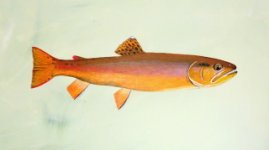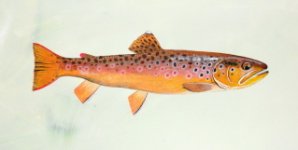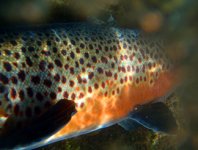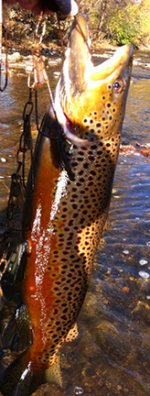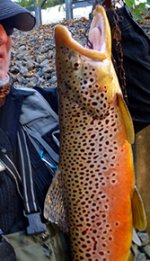F
Fishidiot
Active member
- Joined
- Sep 9, 2006
- Messages
- 9,960
Wild brown trout in streams are less well known than brook trout for coloring up in autumn, but many of them do (as you know). The fish that come in and out of Great Lakes tribs are certainly known for their striking orange and black hues, however small stream fish can really color up as well this time of year, especially, in my experience, in fertile freestone streams. Having spent some time over the years pondering trout coloration and trying to match it with a paintbrush, I’ve certainly come to the conclusion that the colors of autumn brown trout are more ephemeral and difficult to perceive (and paint) than the colors of brook trout. They’re heavy with reds, orange, rust, yellow, and other colors in the “warm” range but also a lot of less obvious olive, brown, and blacks. Anyway, thought I’d post some pics of a brown trout painting in progress which, quite literally, illustrates my struggle to accurately portray these colors and how they seem to divide the flank in horizontal thirds…. and then come to be overlaid with spotting and other typical small details. When many of us look at a colored up wild brown, we often think, “Wow, that’s a beautiful orange sided trout” or we note the buttery yellow flanks. Underneath the spots however, brown trout typically have three “levels” of color running their flank as can be seen in the upper pic (this pic almost looks like a palomino). In other words, when one peels back the spotting, scales, and other surface noise, we see a fish with brown and olive on the back and upper flank, a brownish/red or pinkish/maroon center stripe much like a rainbow, and a lower third of orange or deep yellow. Oftentimes the actual belly of the fish will develop black tones and the fins will darken too (although this is much more noticeable on the Great Lakes fish where the fins are often black). Folks often don’t think of a brown trout as having red on his flanks but this is actually common this time of year. The term “brown” trout is, however, well deserved as the upper body is mostly brown and remains that way seasonally. Oftentimes, especially on big fish, there is substantial olive mixed in on the back and shoulders as well. The lower pic, finished with spots and such, reveals how rather difficult it is to note the three underlying color bands. On most wild browns during most of the year, the reddish middle band is actually more silvery or just lighter than the back. The darkening up and reddish tones however are pretty common this time of year. With respect to the spots, most of the red spots on the back half of the fish will fall right along the lateral line. On the upper body and back, many browns also have reddish spots that are very faint mixed in with the more obvious spots (these aspects of spotting are pretty much the same throughout the year). Take some time to check out the next good looking brownie you get this month and you may notice that the colors are more complex than they seem at first glance.

